Creating an effective SEO proposal: Tips, examples, and a free SEO proposal template
A well-crafted SEO proposal can be your agency’s secret weapon. Think of it as your agency’s polished elevator pitch, strategically designed to pique interest and win over prospects.
This article explores the art of writing a winning SEO proposal to elevate your agency’s client acquisition game. We’ll guide you through the key elements to include in your offers and equip you with expert insights and a free proposal sample.
Download our free ebook with research findings and and sign up to SE Ranking’s news and SEO tips digests!
Click the link we sent you in the email to confirm your email
A professionally prepared SEO proposal sets the stage for a successful partnership. Agencies can use it to demonstrate that they understand clients’ needs and showcase their expertise and commitment.
A comprehensive SEO proposal should include a compelling introduction, detailed SEO analysis, agency information, a breakdown of specific services and deliverables, a clear cost, realistic goals, and precise contractual terms.
Tailor your proposal format to align with the client’s preferences and the specifics of the SEO project to ensure you address unique challenges and goals effectively.
Be clear in your communication and minimize SEO jargon to make your proposal easy to understand, regardless of the client’s technical knowledge.
Incorporate specific numbers, graphs, and charts in the proposal to make it more engaging and visually appealing and simplify complex information.
What is an SEO proposal?
An SEO proposal, or an SEO offer, is your sales pitch. It’s a document that outlines the strategies, techniques, and services you plan to implement to improve the visibility and search engine rankings of your client’s website. Typically, the proposal is created when pitching SEO services to potential clients or outlining the scope of work for existing clients.
Professional SEO proposals often include a presentation of your agency’s brand and services. They also contain the results of your research on the prospect’s current situation, solutions to improve it, and the cost of your services. This secures a comprehensive and individual approach to your SEO clients and their specific goals.
Text documents with a clear structure and detailed explanations are the most common SEO proposal type. You can also include charts, graphs, infographics, and screenshots to enhance overall visual appeal. Some agencies are exceptionally creative and prepare interactive presentations with clickable elements or video proposals.
When deciding which format to choose, consider your agency’s policies, client type, and project specifics. If you have a conservative client, use a standard text format with tables and graphs. If your client values creativity, you might want to create an interactive SEO proposal. But regardless of format, clearly outlining SEO strategies, timelines, deliverables, and pricing is always the way to go.
What to include in your SEO proposal
When crafting a good SEO proposal, it’s crucial to create a comprehensive document that:
- Helps establish expectations, align goals, and provide a basis for successful collaboration
- Serves as a roadmap for both the SEO agency (you) and the client.
- Ensures that both parties have a clear understanding of the SEO campaign’s objectives, strategies, timelines, and costs.
As an agency, your proposal should demonstrate your expertise, highlight the value of your services, and present a personalized roadmap to achieve the client’s SEO goals. In this section, we will explore how to create such one. You can also download our free SEO proposal template and use it when preparing your pitch.
SEO proposal summary
The overview (or summary) section sets the tone for your entire proposal. It serves as the starting point that grabs the client’s attention from the outset.
In this executive summary section, you need to summarize the main points, objectives, and benefits your agency will provide. To ensure clarity, keep it focused and straightforward. Remember that not all clients are well-versed in the intricacies of SEO, so avoid overwhelming them with technical jargon. Instead, use clear and accessible language that allows prospects to quickly grasp the value you bring.
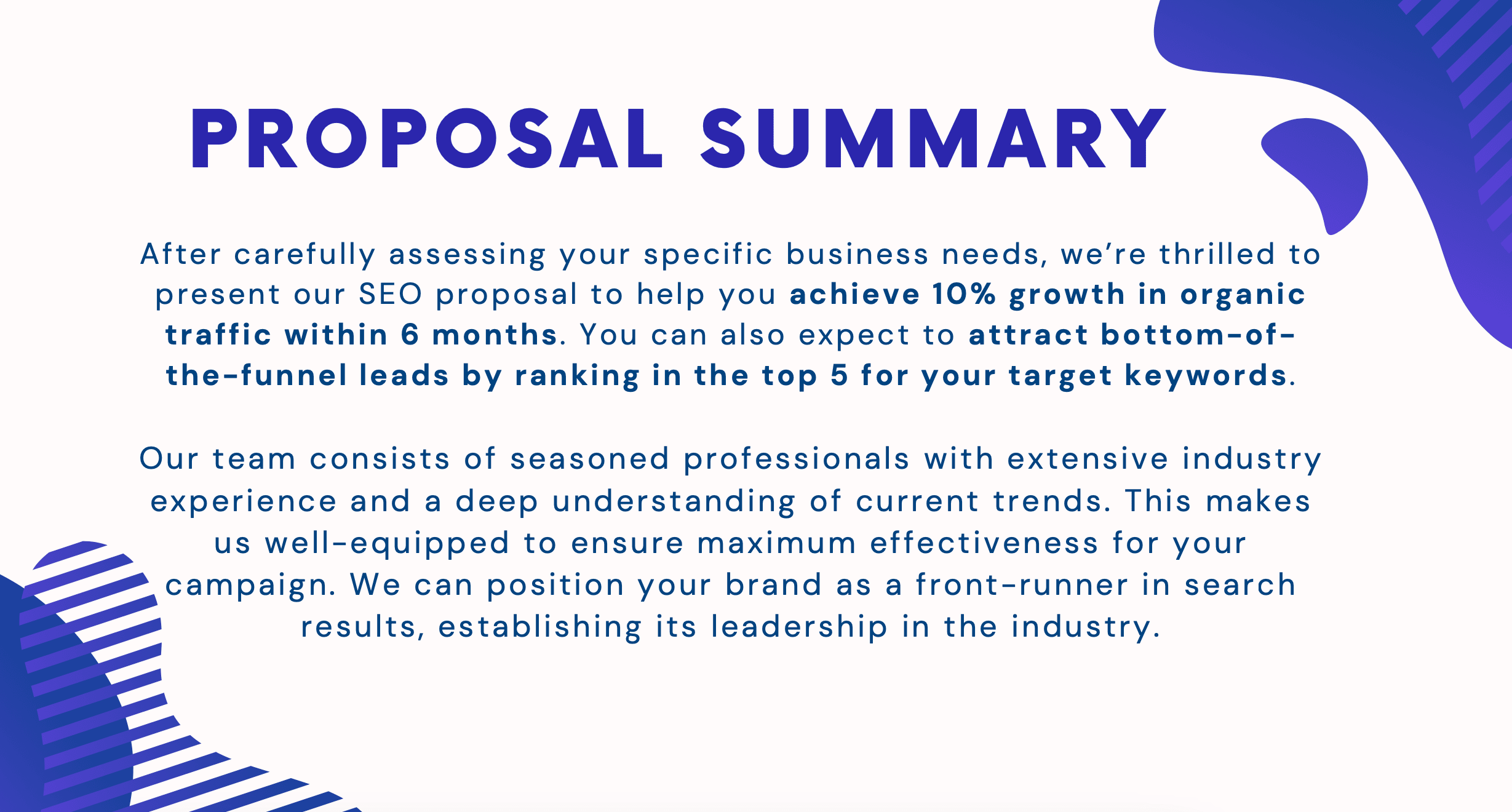
Specific SEO insights
This section is extremely important because it shows that your agency has conducted thorough research and analysis of your client’s current online performance. This personalized approach is a powerful way to build trust and confidence with your client.
Analyze their website and competitors, identify potential areas for improvement, and present this information in your SEO proposal. Show your agency’s attention to detail and ability to provide valuable recommendations.
During this step, you must explain how dealing with the issues you identified can help your client reach their business goals.
For instance, let’s say the website audit you performed on your prospect’s website found unindexed product pages or below-average page loading speeds. You must communicate to the client that these issues can lead to reduced online visibility, lower customer engagement, and missed business opportunities. Reassure the client that fixing them can boost their online presence, improve customer experience, and drive sales or conversions.
Your task is to bridge the gap between technical SEO issues and business impacts.
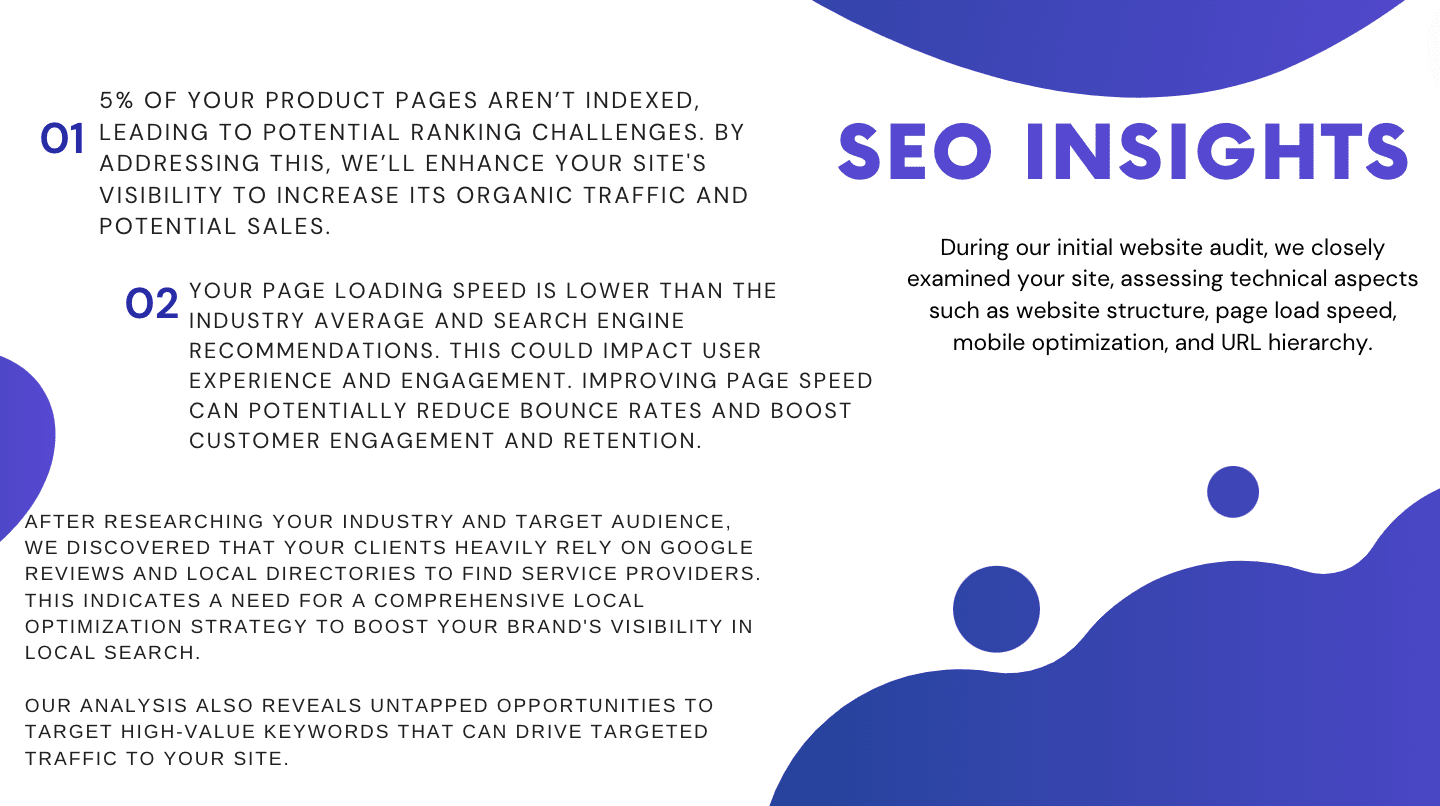
Agency profile
Before you can convince your leads to trust your SEO agency, use your SEO proposal to introduce yourself and showcase all the things that set your agency apart from others. This section is your chance to show off your unique qualities and give potential clients compelling reasons to choose your agency.
Present your agency with a brief overview of your background, experience, and credentials. Here’s how:
- Highlight key achievements.
- Mention notable clients and any industry recognition or certifications.
- Explain your core values and approach to SEO that drive results.
- Describe your unique value proposition, emphasizing what sets you apart from others.
This will build trust and credibility in the client’s mind.

If your agency already has a well-designed mission statement, be sure to include it in your SEO services proposal. Here is how SE Ranking did it:
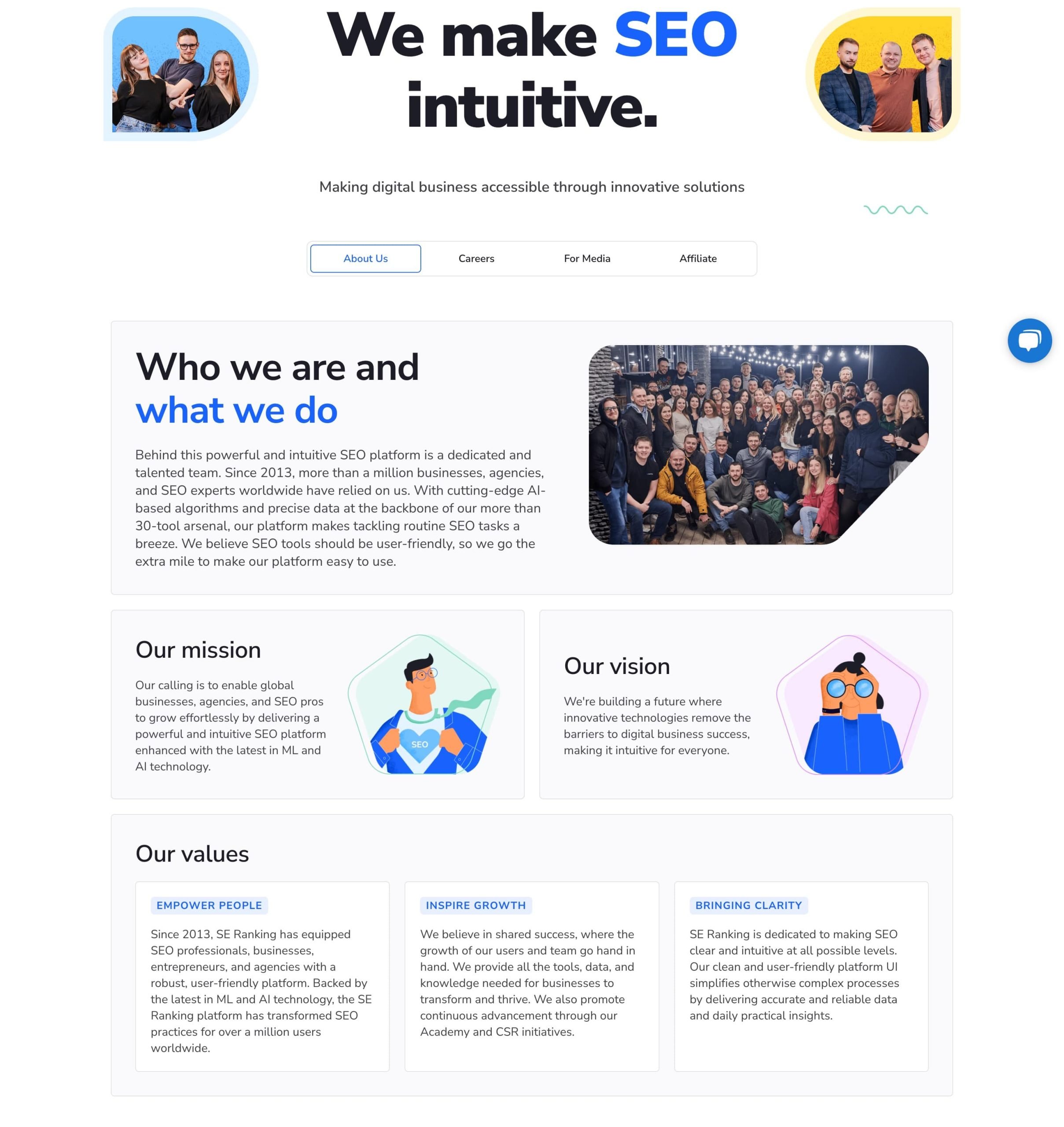
Services and investments
When writing this section of your SEO proposal:
- Clearly outline your agency’s services and emphasize their importance for the client’s SEO success.
- Address the client’s specific pain points and show them how your tailored solutions can address their challenges.
- Break down the SEO process into clear stages or milestones, explaining the specific tasks and deliverables involved.
- Include all relevant details, such as the number of blog posts, backlinks, reports, or audits to be delivered within a set timeframe.
- Mention the tools and techniques used to perform these tasks effectively.
Your agency should also educate the client about the broader impact of SEO, which extends beyond improving search rankings. Help your client understand that SEO plays a vital role in building online authority, enhancing brand visibility, and generating leads for long-term business growth.
Make a connection between the services you offer and the associated costs. When presenting the price, frame it as an investment rather than just a cost. By positioning your services as an investment in business growth, you highlight the long-term value and return on investment (ROI) your clients can expect to receive.
Clearly outline the investment required and fees involved. Be transparent about pricing structures, whether it’s a monthly retainer, project-based pricing, a customized package, or a pay-for-performance SEO model. Explain the value your agency offers at different price points and how the investment will deliver a positive ROI for the client.
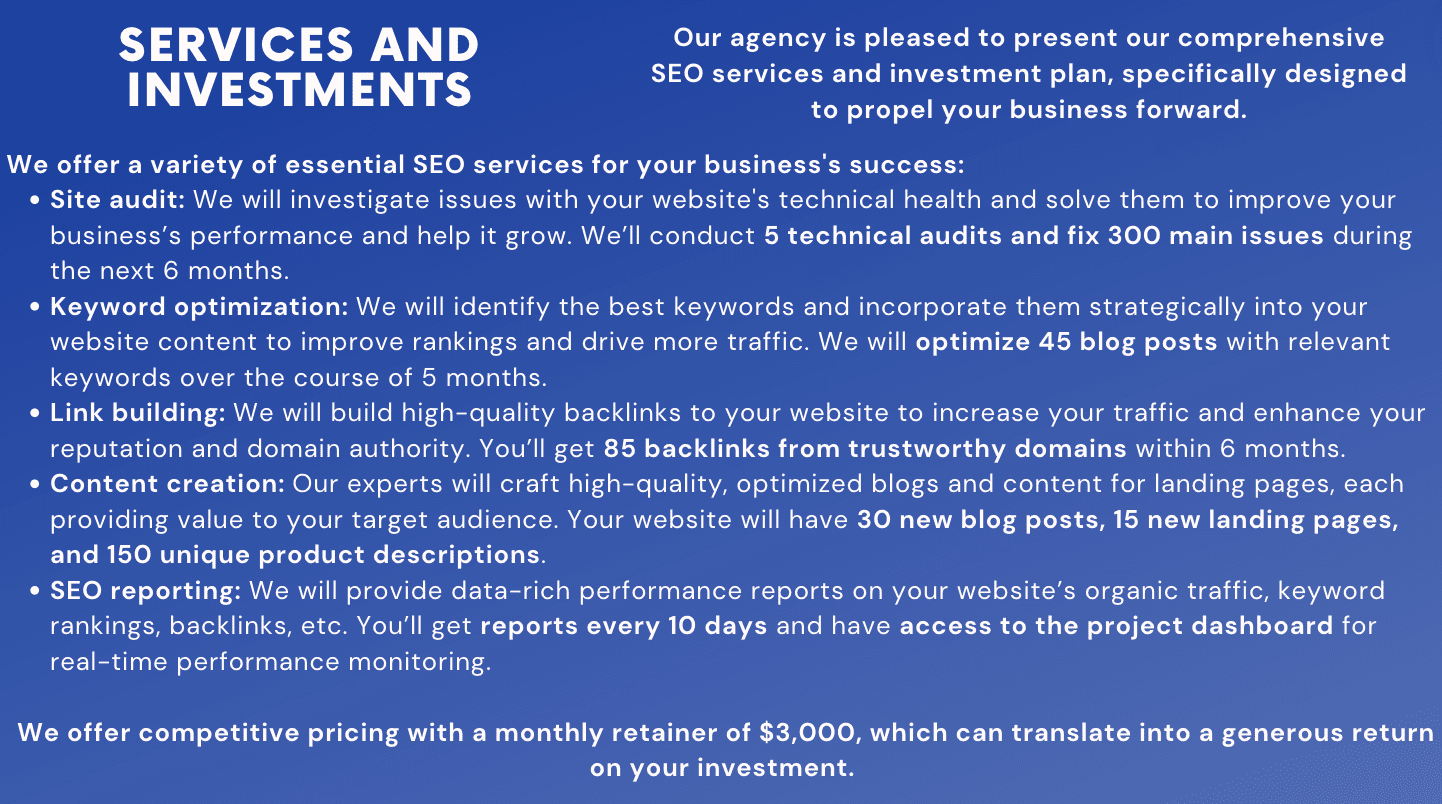
Goals and timeframes
Set clear and realistic goals that align with the client’s objectives. Outline the specific metrics that you plan to track and set a realistic timeline for achieving these goals. This helps manage client expectations and ensures that both parties have a shared understanding of the project’s timeline.
Follow the SMART system:
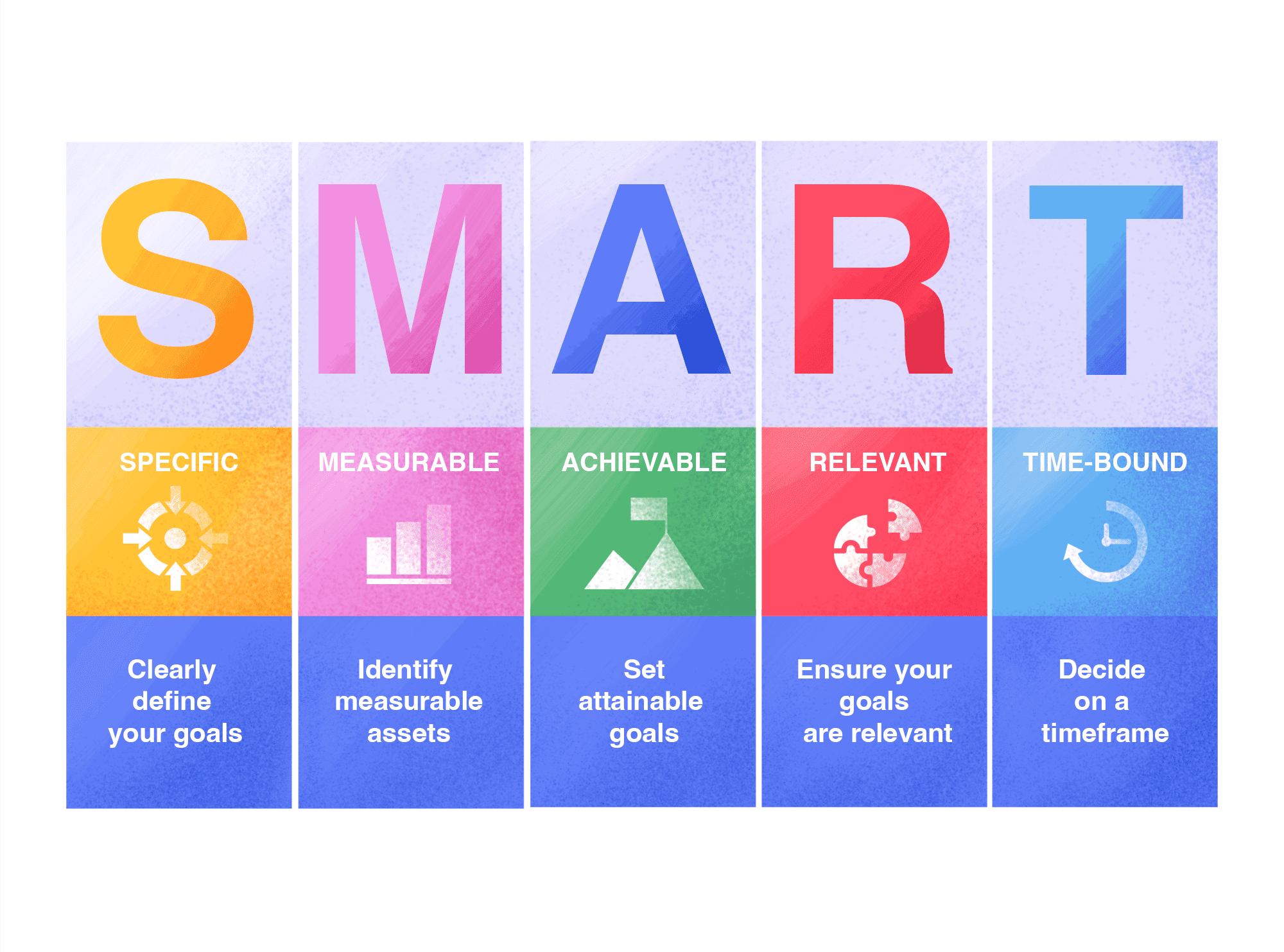
- S stands for specific: Clearly define what you want to achieve through your SEO campaign. Aim for specific objectives such as “increase organic traffic by 30% in six months.”
- M stands for measurable: Measurable goals help you assess your SEO efforts more accurately. For example, you can aim for a certain number of keywords ranking in the top 10 or a 30% increase in organic traffic. You can also track conversion rates or lead generation.
- A stands for achievable: Set realistic and attainable goals based on your client’s website performance, industry competition, and available resources. Avoid setting unattainable goals that might lead to client frustration. Strike a balance between ambition and feasibility.
- R stands for relevant: Align your goals with the client’s broader business objectives. Consider how achieving these SEO goals will contribute to their overall marketing strategy and help drive business growth.
- T stands for time-bound: Set a specific timeframe for achieving your goals. For example, you could aim to acquire 30 new backlinks within two months or improve keyword rankings within three months.

Feedback from your previous clients
Include social proof and testimonials from satisfied clients to build even more credibility and trust. Highlight any success stories, case studies, and positive feedback from past clients, especially if they have achieved overwhelmingly positive results through your SEO services. This will reassure the agency that you have a proven track record of delivering on your promises.
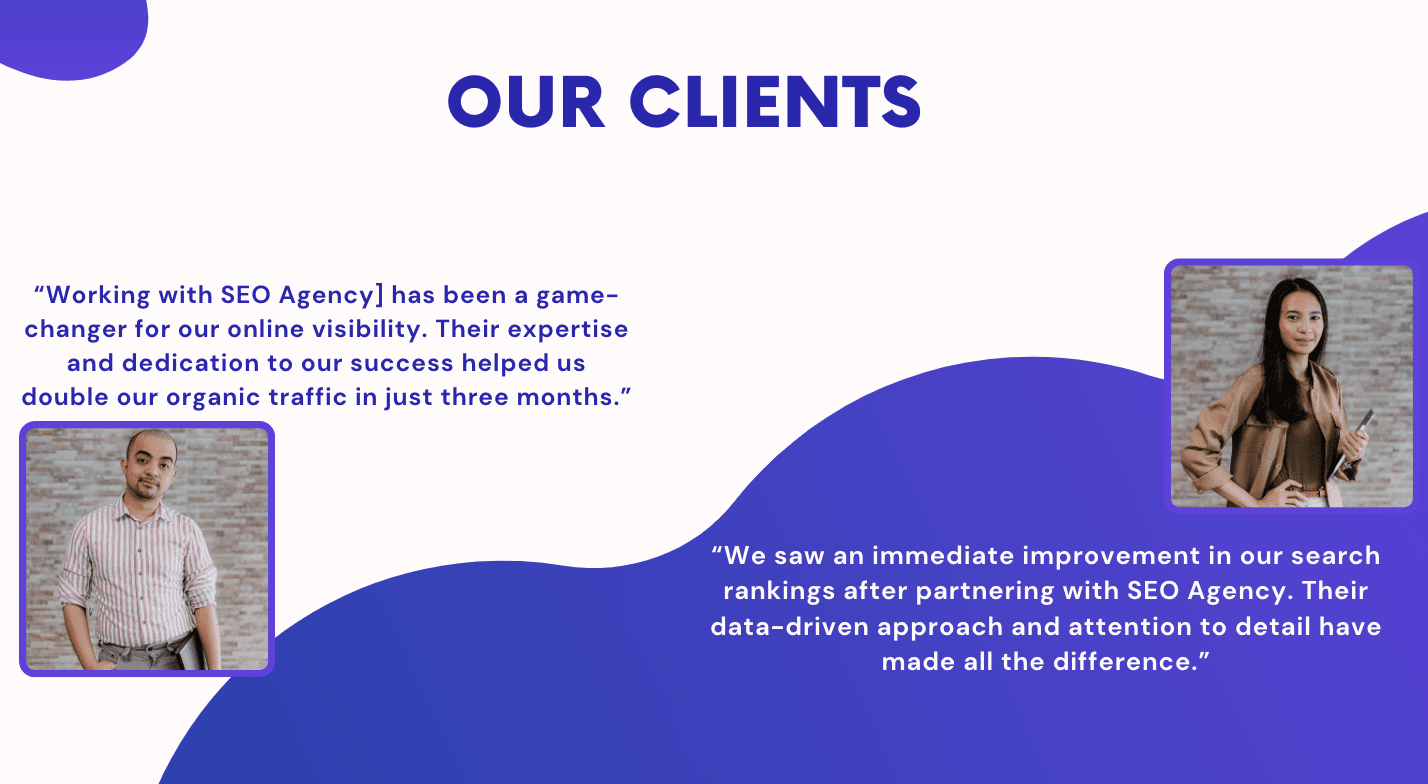
Your client’s next steps
This section of your search engine optimization proposal serves to guide your clients on all the essential steps required to kickstart their campaign. By providing clear direction, you set the foundation for their progress.
To initiate the SEO campaign smoothly, it’s essential to present a comprehensive list of the information, access, and resources the agency requires. This list may include the following elements:
- Access to their website’s CMS
- Credentials for Google Analytics and Google Search Console
- Existing content assets
- Any other pertinent data
By communicating these prerequisites early on, you can smooth the onboarding process and ensure a painless start to the campaign. Build and follow your SEO onboarding checklist so you don’t miss any important pieces of information when you begin working on your client’s project.
Conclude your SEO proposal with a compelling сall to action, encouraging the agency to take the next step. Clearly outline the desired action, whether it’s scheduling a call, signing a contract, or requesting further information. Create a sense of urgency by emphasizing the benefits of taking prompt action.
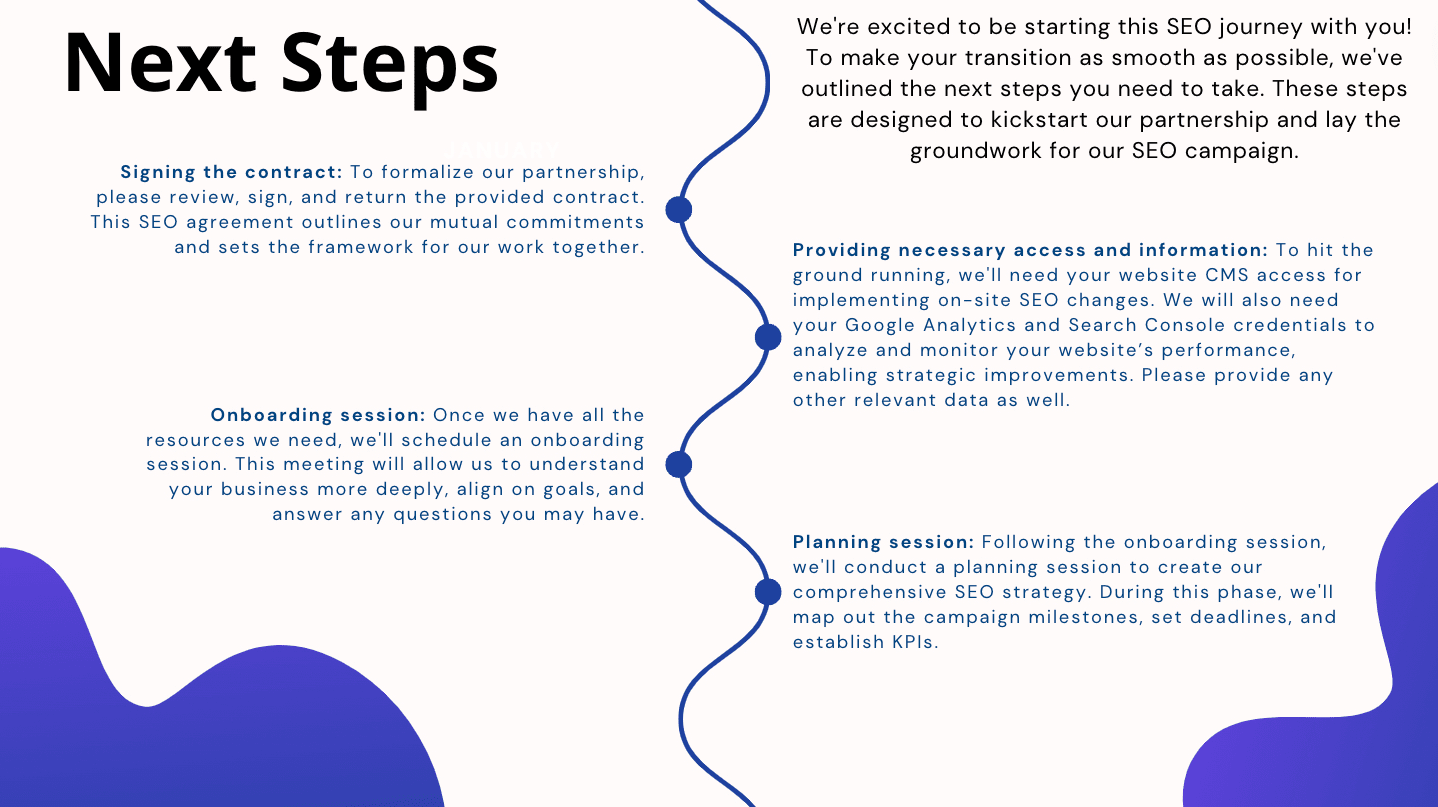
Contract
This section of the SEO proposal is crucial, as it defines the legal detail of your professional relationship with the client. It provides clarity on the nature and scope of services, payment terms, obligations of both parties, contract duration, and the dispute resolution process.
If possible, use simple language when crafting this section to ensure mutual understanding of terms. Clearly define industry-specific terms to avoid confusion. Mention parties of the contract, services being offered, deadlines, and the responsibilities for each party.
Add the following sections:
- Payment terms: Clearly outline the payment structure, due dates, and any applicable late fees.
- Termination clause: Specify the conditions under which your cooperation can be terminated by either party and the implications of termination.
- Dispute resolution: Define the process for resolving disputes that may arise.
- Confidentiality clause: If necessary, include a section that assures the client that their sensitive information will be handled with the utmost confidentiality.
We’ve prepared a free SEO contract template that you can download and use as a part of your SEO proposal.
Writing your SEO Proposal: Pro tips
We’ve gathered tons of invaluable insights from seasoned agencies and influential voices in the industry to provide you with practical strategies and insider advice.
- Keep it simple
Try to make your SEO proposal clear and straightforward. Independent consultant Geoff Kennedy advises removing any superfluous details (i.e., the fluff).

- Relate to business goals
Demonstrate how your SEO strategies and actions will support the client’s business goals. This is what Itamar Blauer from StudioHawk recommends focusing on in your SEO offer.

- Make the pricing structure clear
A clear and transparent pricing structure can be a determining factor for a client to choose your services. Ulrika Viberg from Unikorn recommends placing the pricing or investment details early on in the proposal and then repeating them in the end with more details.

- Forecast potential results
To help clients visualize the potential benefits of your SEO services, provide them with an estimate of possible results. Anthony Barone from StudioHawk recommends using your client’s data for 12-month forecasting.

- Personalize your proposal
In an industry that can often feel impersonal and technical, a personal touch can make all the difference. Ulrika Viberg recommends introducing your team to the client to create a personal connection.

And finally, here’s a piece of advice all the experts agree on: clearly explain what the client will get in the end and why each service that you provide is important.
- Learn more about your prospects and their niches
Gather as much information as you can about your prospective clients. This includes their specific industries or niches. Run keyword research and competitive analysis as well.

Use SE Ranking’s Competitive Research Tool to research both your client’s website and its main competitors. It reveals key metrics like Domain and Page Trust, organic and paid traffic, referring domains, backlinks, organic keywords, ad history, and more. It also gives you access to a list of your client’s organic and paid competitors. You can use the same tool to analyze and compare them.
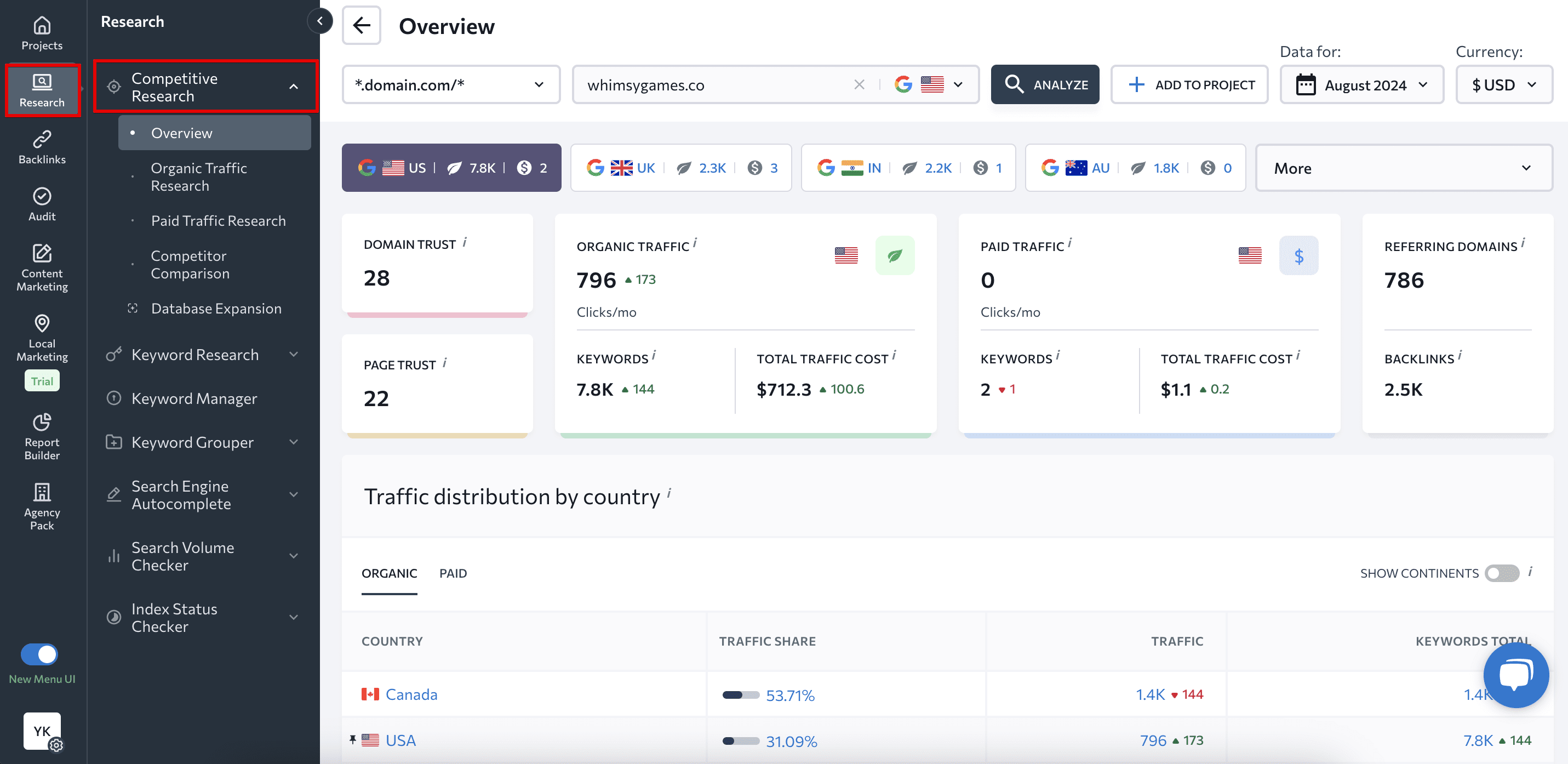
- Audit your client’s website
Conduct a website audit of your client’s website to assess its overall health and optimization level for search engines.

You can use tools like SE Ranking’s Website Audit to identify all errors on your prospect’s website. All issues are grouped according to 19 distinct categories with marks showing their severity level.
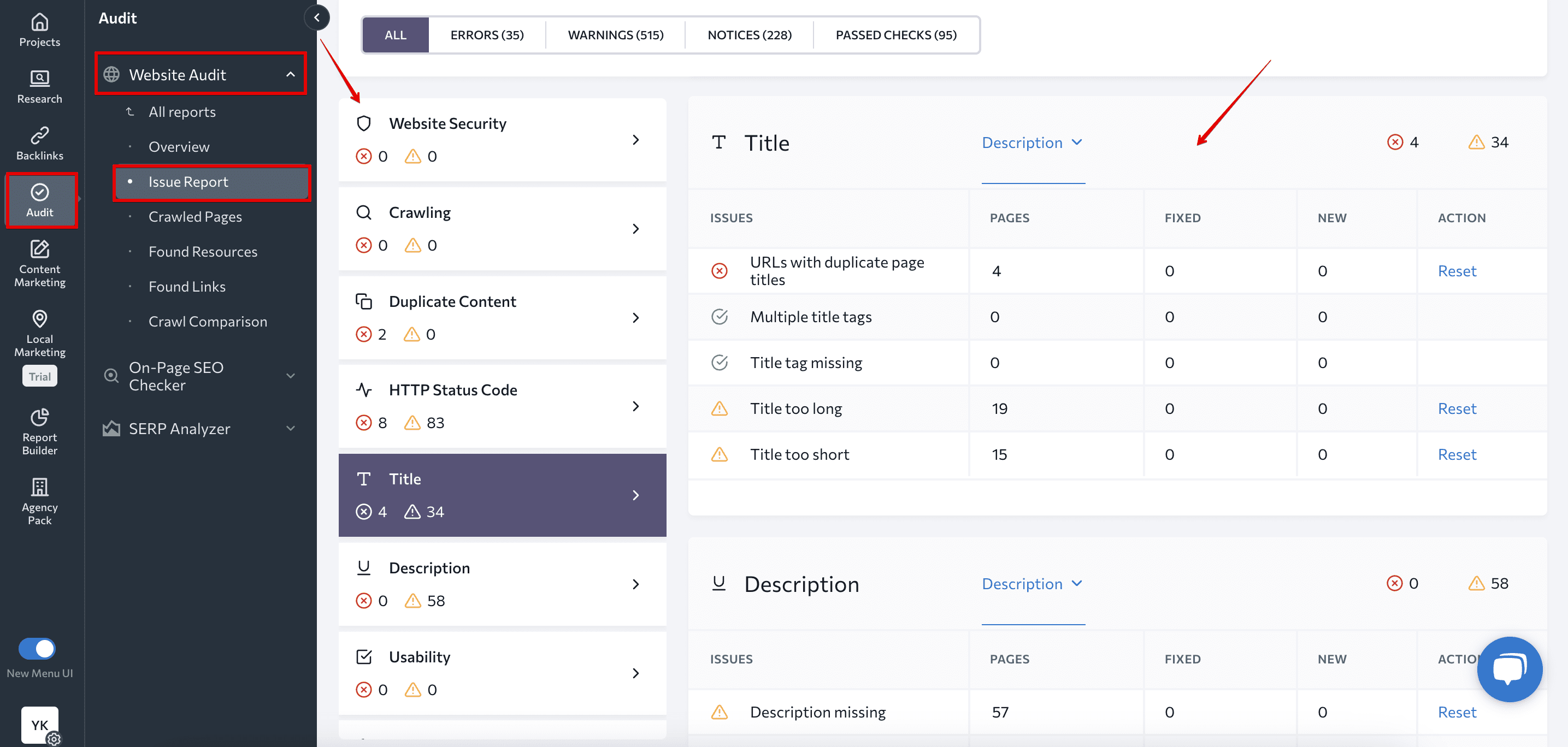
If you need this information in report format, use the SEO Report Generator. With it, you can craft visually appealing reports packed with data on your client’s rankings, competitors, website technical issues, and more. This approach allows you to present essential data in a clear format and demonstrate your commitment to the project.
SE Ranking also provides white-label SEO software, which means you can customize the platform as your own and make reports match your brand. Use your brand colors, logos, and domain name to make it seamless with your business identity. If you decide to share access with your client, they won’t see any references to SE Ranking.
Wrapping Up
The process of creating a winning SEO proposal can be rewarding despite how challenging it can be. An effective proposal demands a strategic approach and deep understanding of the client’s specific needs. The tips, a free template, and examples provided in this article are designed to help you craft offers that resonate with potential clients, stand out from the crowd, and win you new projects.
Now is the time to take this knowledge and apply it! Start creating persuasive, compelling SEO proposals to attract new clients eager to hire your agency.

